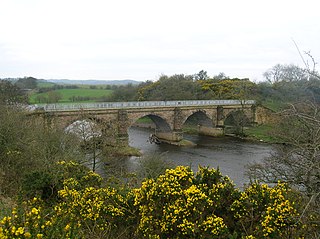
A viaduct is a specific type of bridge that consists of a series of arches, piers or columns supporting a long elevated railway or road. Typically a viaduct connects two points of roughly equal elevation, allowing direct overpass across a wide valley, road, river, or other low-lying terrain features and obstacles. The term viaduct is derived from the Latin via meaning "road", and ducere meaning "to lead". It is a 19th-century derivation from an analogy with ancient Roman aqueducts. Like the Roman aqueducts, many early viaducts comprised a series of arches of roughly equal length.

An arch bridge is a bridge with abutments at each end shaped as a curved arch. Arch bridges work by transferring the weight of the bridge and its loads partially into a horizontal thrust restrained by the abutments at either side, and partially into a vertical load on the arch supports. A viaduct may be made from a series of arches, although other more economical structures are typically used today.

Prestressed concrete is a form of concrete used in construction. It is substantially "prestressed" (compressed) during production, in a manner that strengthens it against tensile forces which will exist when in service. It was patented by Eugène Freyssinet in 1928.

The Seven Mile Bridge is a bridge in the Florida Keys, in Monroe County, Florida, United States. It connects Knight's Key in the Middle Keys to Little Duck Key in the Lower Keys. Among the longest bridges in existence when it was built, it is part of the Overseas Highway in the Keys, which is part of the 2,369-mile (3,813 km) U.S. Route 1.

The Overseas Highway is a 113-mile (181.9 km) highway carrying U.S. Route 1 (US 1) through the Florida Keys to Key West. Large parts of it were built on the former right-of-way of the Overseas Railroad, the Key West Extension of the Florida East Coast Railway. Completed in 1912, the Overseas Railroad was heavily damaged and partially destroyed in the 1935 Labor Day hurricane. The Florida East Coast Railway was financially unable to rebuild the destroyed sections, so the roadbed and remaining bridges were sold to the state of Florida for $640,000.

A trestle bridge is a bridge composed of a number of short spans supported by closely spaced frames. A trestle is a rigid frame used as a support, historically a tripod used to support a stool or a pair of isosceles triangles joined at their apices by a plank or beam such as the support structure for a trestle table. Each supporting frame is a bent. A trestle differs from a viaduct in that viaducts have towers that support much longer spans and typically have a higher elevation.
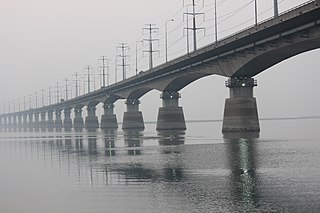
Jamuna Multi-purpose Bridge, also known as Bangabandhu Bridge, is a bridge built over the river Jamuna in Bangladesh. The bridge was opened in June 1998. With a lenth of 4.8 kilometres, it is the second longest bridge of Bangladesh. It connects Bhuapur on the Jamuna River's east bank to Sirajganj on its west bank. 90% of this bridge is under Tangail district and 10% under Sirajganj district. It was the 11th longest bridge in the world when constructed in 1998 and at present is the 6th longest bridge in South Asia. The Jamuna River, which it spans, is one of the three major rivers of Bangladesh, and is fifth largest in the world in discharge volume.

The Narrows Bridge is a freeway and railway crossing of the Swan River in Perth, Western Australia.
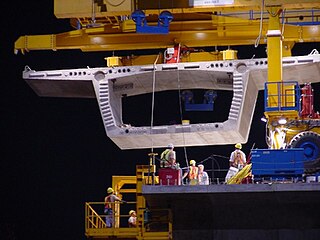
A segmental bridge is a bridge built in short sections, i.e., one piece at a time, as opposed to traditional methods that build a bridge in very large sections. The bridge is made of concrete that is either cast-in-place or precast concrete.
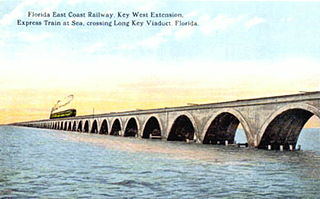
The Overseas Railroad was an extension of the Florida East Coast Railway to Key West, a city located 128 miles (206 km) beyond the end of the Florida peninsula. Work on the line started in 1905 and it operated from 1912 to 1935, when it was partially destroyed by the Labor Day Hurricane. Some of the remaining infrastructure was used for the Overseas Highway.

The Bahia Honda Rail Bridge is a derelict railroad bridge in the lower Florida Keys connecting Bahia Honda Key with Spanish Harbor Key. It was originally part of the Overseas Railway, but the state of Florida purchased it from the Florida East Coast Railway (FEC) after the 1935 Labor Day Hurricane and converted it for automobile use as part of the Overseas Highway in 1938. After a replacement Bahia Honda Bridge was opened in 1972, two spans of the old bridge were removed for the safety of boat traffic and to prevent pedestrian access to unsafe parts of the bridge.

The Hampden County Memorial Bridge is a reinforced-concrete arch bridge that spans the Connecticut River between Springfield, Massachusetts and West Springfield, Massachusetts, constructed in 1922. The bridge is owned by Massachusetts Highway Department. It spans 209 feet (64 m) and rises 29.71 feet (9.06 m) above the river.
The Florida Keys Overseas Heritage Trail is a 106-mile (171 km) paved rail trail—a multi-use bicycle and pedestrian facility—being constructed between Key Largo and Key West in the Florida Keys. As of January 2022, 90 mi (140 km) of the trail has been constructed.

The Godavari Arch Bridge is a bowstring-girder bridge that spans the Godavari River in Rajahmundry, India. It is the latest of the three bridges that span the Godavari river at Rajahmundry. The Havelock Bridge being the earliest, was built in 1897, and having served its full utility, was decommissioned in 1997. The second bridge known as the Godavari Bridge is a truss bridge and is India's third longest road-cum-rail bridge crossing a water body.
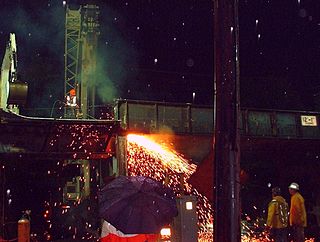
Rapid bridge replacement or accelerated bridge construction (ABC) is a technique that allows bridges to be replaced with minimum disruption to traffic. The replacement bridge is constructed on a site near the bridge to be replaced. When it is completed, the old bridge is cut away and removed using self-propelled modular transporters (SPMTs). Then the SPMTs lift the new bridge, transfer it to the work site and put it in place. Often the highway or railroad carried by the bridge is closed for just one weekend. Conventional techniques typically replace half a bridge at a time, with all highway traffic redirected under the other bridge half, often for a year or more, while construction progresses. Accelerated bridge construction (ABC) alternatives consist of ABC components and ABC techniques. Components can be categorized into prefabricated bridge elements or prefabricated bridge systems. ABC involves fabrication of these elements or systems off-site in a regulated environment, and transporting those to site for installation. Related processes such as lifting, placement, transportation, embankment construction are termed as ABC techniques.
The Sharavati Bridge is a railway bridge, south of Honnavar, in the state of Karnataka, India, completed in 1994. It carries the Konkan Railway over the Sharavati river.

A double tee or double-T beam is a load-bearing structure that resembles two T-beams connected to each other side by side. The strong bond of the flange and the two webs creates a structure that is capable of withstanding high loads while having a long span. The typical sizes of double tees are up to 15 feet (4.6 m) for flange width, up to 5 feet (1.5 m) for web depth, and up to 80 feet (24 m) or more for span length. Double tees are pre-manufactured from prestressed concrete which allows construction time to be shortened.

A launching gantry is a special-purpose mobile gantry crane used in bridge construction, specifically segmental bridges that use precast box girder bridge segments or precast girders in highway and high-speed rail bridge construction projects. The launching gantry is used to lift and support bridge segments or girders as they are placed while being supported by the bridge piers instead of the ground.
Clarence Stanley Coe was an American master bridge builder and railroad civil engineer, who supervised the planning and building of the Florida East Coast Railway's Seven Mile Bridge, linking the Florida Keys to Marathon, Monroe County, which, when completed in January 1912, was acclaimed as the longest bridge in the world and an engineering marvel. Later, Coe was appointed the first city manager of Miami, Florida, and after that was appointed chief engineer of Duval County, Florida.
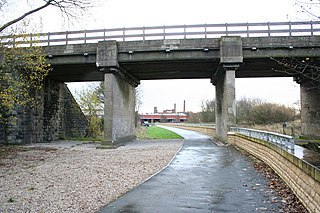
The Adam Viaduct is a grade II listed concrete underbridge in Wallgate, Wigan. The bridge, constructed in 1946, is the earliest 'post-tensioned' prestressed concrete railway bridge in the United Kingdom, with only some examples in Switzerland being earlier. It is bridge number 54 on the Kirkby branch line and is at a line distance of 18 miles 1,032 yards (29.91 km).






















